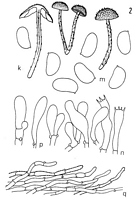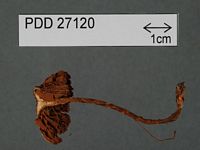|
 Inocybe latericia Inocybe latericia
BiostatusPresent in region - Indigenous. Non endemic
Images (click to enlarge)
Caption: Inocybe latericia (type): l;c, carpophores; m, spores; n, basidia; p, cheilocystidia; q, cuticle. | 
Caption: ZT69-035 , Holotype
Owner: E. Horak: © Creative Commons Attribution-Noncommercial 3.0 New Zealand | 
Caption: Dried type specimen
Owner: Herb PDD |
Article: Horak, E. (1978) [1977]. Fungi Agaricini Novaezelandiae. VI. Inocybe (Fr.) Fr. and Astrosporina Schroeter. New Zealand Journal of Botany 15(4): 713–747 (http://www.rsnz.org/publish/abstracts.php).
Description: Pileus 15-30 mm diam., hemispherical, becoming
convex or campanulate, margin incurved; brown to fuscous, uniformly coloured;
dry, covered with con-colorous, erect, conical, persistent scales and squamules,
veil remnants absent, margin estriate. Lamellae adnate to sinuate, ventricose,
crowded (L-20, 1-7); dark brown from the beginning, edge conspicuously albofimbriate.
Stipe 30-60 x 2-3 mm, cylindrical, equal; concolorous with pileus, with a pink
tomentum of mycelium at base, covered with scattered concolorous, persistent
dots and squamules, no trace of cortina; dry, solid, single and cespitose. Context
[Line of missing text] after bruising or
exposure. Odour and taste unpleasant, but not spermatic. Chemical reactions
on pileus: KOH-negative.
Spores 9-11.5 x 5-6.5 µm, reniform to phaseoliform,
brown, smooth. Basidia 30-40 x 6-8 µm, 4- spored. Cheilocystidia 20-40 x 6-1
µm, clavate to subfusoid, hyaline, thin-walled, scattered on edge Pleurocystidia
absent. Cuticle a trichoderm of cylindrical, not gelatinised hyphae (4-8 µm
diam.), encrusted with yellow-brown (KOH) pigment. Clamp connections present.
Habitat: On soil among moss and litter of Nothofagus
(N. fusca, N. menziesii). New Zealand.
Notes: This species is well characterised by the
reddening context in the pileus and stipe. This is reminiscent of I. bongardi
(Weinm.) Quel. and I. cervicolor (Pers. ex Pers.) Quel., two taxa which
occur in coniferous and deciduous forests of Eurasia, but spores and cheilocystidia
of this New Zealand fungus are considerably smaller.
|